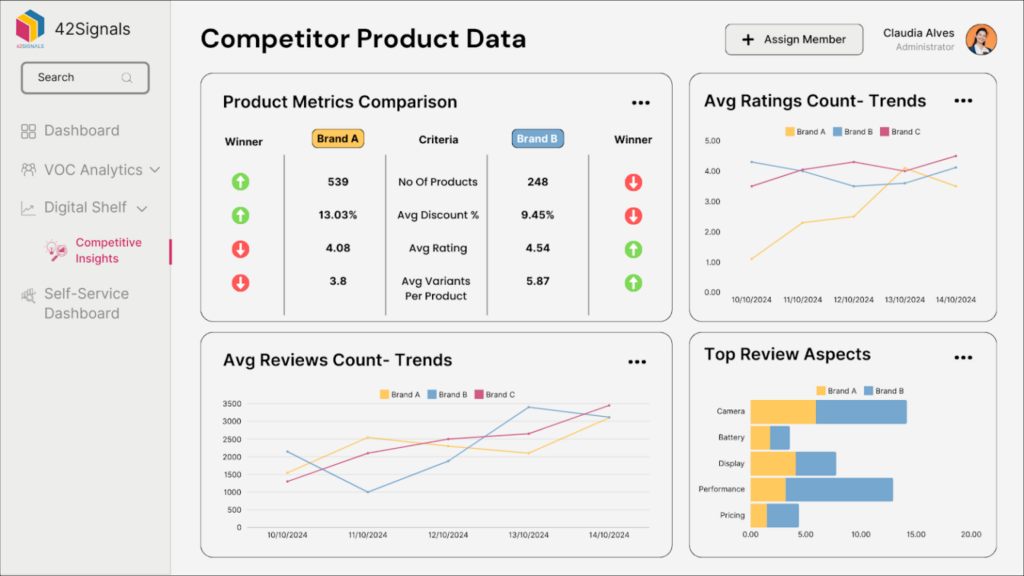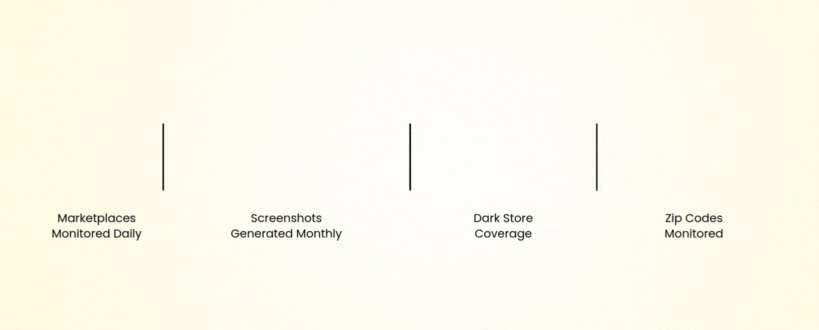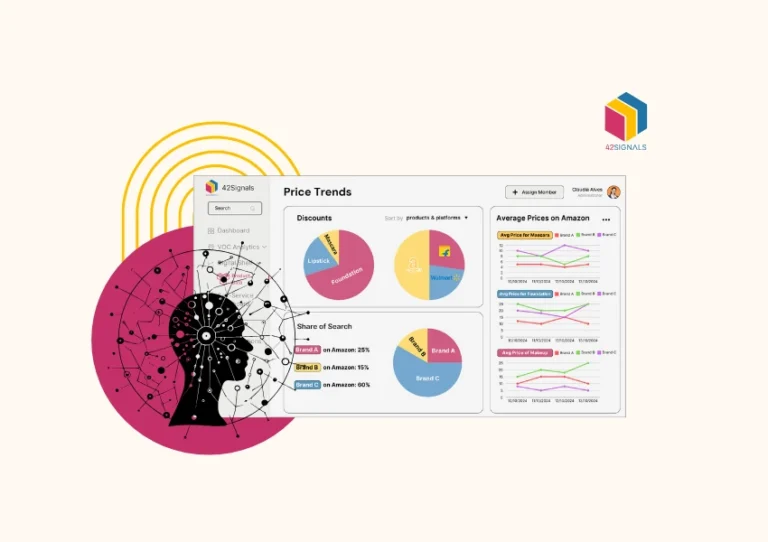Setting prices too high can alienate customers, and low prices may mean sacrificing profit margins. The easy solution here is to go with a competitor price comparison software. In essence, these tools provide the right data for brands to optimize pricing strategies and maintain relevance in crowded markets.
Let’s explore how these platforms work, their role in shaping pricing strategies, and why solutions like 42Signals ecommerce analytics are becoming indispensable for modern retailers.
Why Businesses Need Competitor Price Comparison Software?

Gone are the days of static pricing. Consumers now have instant access to price comparisons across dozens of retailers, thanks to search engines, price-tracking apps, and marketplace algorithms. A product listed at $50 on your website may be listed at $45 on Amazon and $48 on Walmart.
A customer with an intent to purchase will be looking at multiple platforms and these changes in prices mean they would opt for the cheapest alternative. ‘
Competitor price comparison software automates this process by continuously tracking competitors’ prices, promotions, and inventory levels. For example, if a rival drops the price of a bestselling item by 10%, the software alerts you, enabling quick adjustments.
This agility makes a huge difference when there are multiple competitors selling similar products.
Core Features of Competitor Price Comparison Tools
1. Competitor Analysis Dashboard: Your Command Center
A good competitor analysis dashboard shows you data from multiple sources and integrates them into a single interface. That would mean seeing your competitors’ pricing trends, discount patterns, and stock availability at a glance.

For instance, if a competitor consistently undercuts your prices on weekends, this data would be visible on the dashboard allowing your brand to make the right decisions.
You can then schedule timed discounts or bundle deals to counteract their strategy. Advanced tools even track competitors’ shipping costs, return policies, and customer reviews—factors that influence purchasing decisions beyond just price.
2. Digital Shelf Analytics: Beyond Pricing
Although pricing is one of the most critical factors, the digital shelf is also equally important in understanding all the different factors that affect online performance. This means looking at search ranking, images, descriptions, and ratings.

Digital shelf analytics tools monitor how products perform with respect to competitors and the category itself.
Suppose your product page for wireless headphones has fewer reviews than a competitor’s. The analytics platform identifies this gap, prompting you to encourage customer feedback or improve content quality. Pairing this with price data ensures your products are both competitively priced and prominently displayed.
3. Competitor Insights: Turning Data into Strategy
Competitor insights are also very important to understand all the different strategies the competition adopts in terms of pricing, discounts, product range, product availability, and much more.

Image Source: Klue
For example, the software might reveal that competitors raise prices during peak shopping seasons, creating an opportunity for you to capture budget-conscious shoppers by holding steady.
Platforms like 42Signals ecommerce analytics go further by offering predictive analytics. Using historical data, they forecast how competitors might react to your price changes, allowing you to test scenarios without risking revenue.
42Signals in Action: Smarter Competitor Monitoring for ECommerce

42Signals stands out in the crowded field of competitor monitoring software by combining granular price tracking with holistic market intelligence. The platform offers:
- Real-Time Alerts: Instant notifications when competitors adjust prices or run flash sales.
- Category Analysis: Insights into which products competitors bundle together, new items entering the market, and average price points of the category that reveal upselling opportunities.
- Keyword and Product Metrics: Analysis of competitors’ keywords, titles, and descriptions to refine your product listings.
A skincare brand using 42Signals, for instance, discovered that rivals were offering free samples with purchases over $50. By mirroring this tactic while slightly lowering prices, the brand increased its conversion rate by 18% in one quarter.
How to Choose the Best Competitor Price Comparison Software?
Not all tools are created equal. When evaluating options, prioritize platforms that offer:
- Comprehensive Competitor Coverage: Can the software track regional retailers, marketplaces, and niche players?
- Integration Capabilities: Does it sync with your existing ecommerce platforms (e.g., Shopify, WooCommerce) or ERP systems?
- Customizable Alerts: Avoid data overload by setting thresholds (e.g., notify only if a price drops by 5% or more).
- Scalability: Ensure the tool grows with your business, handling increased SKUs or global expansion.
The Bottom Line: Why Pricing Intelligence Can’t Be Ignored
Competitor price comparison software has become a critical part of the ecommerce business operations. Retailers using such tools see an average of 12% higher profit margins and 25% faster inventory turnover.
By mastering competitor insights and digital shelf analytics, businesses can:
- Avoid price wars by differentiating through value-added services.
- Identify gaps in competitors’ assortments to launch complementary products.
- Optimize promotions based on real-time demand signals.
In the age of Amazon and TikTok Shop, where prices change by the minute, manual monitoring is futile. Platforms like 42Signals ecommerce analytics empower brands to stay agile, responsive, and profitable.
Conclusion
Pricing is both an art and a science. Competitor price comparison software provides the scientific backbone—data, trends, and forecasts—while freeing teams to focus on creative strategies.
Whether you’re a small retailer or a global enterprise, investing in a competitor analysis dashboard and digital shelf analytics ensures your prices aren’t just numbers but strategic assets that drive sales.
Tools like 42Signals help brands of all sizes with their competitor analysis needs. If you are –
- Looking to understand your competitors
- Know what are their bestselling products
- Learn pricing strategies
- And, improve your own operations
Schedule a demo with us today.

Frequently Asked Questions in Competitor Price Comparison Software
How to compare competitors’ pricing?
To compare competitors’ pricing effectively, you should follow a structured process:
- Identify Direct Competitors – Focus on brands offering similar products or services to the same target audience.
- Gather Pricing Data – Manually collect prices from competitor websites, marketplaces, and physical stores, or use automated tools like 42Signals or Prisync for real-time tracking.
- Compare Total Cost – Include additional costs like shipping, taxes, and discounts to assess the true customer price.
- Analyze Value Offered – Evaluate not just the price but also what customers receive (warranties, support, quality, etc.).
- Monitor Price Trends – Track how often competitors change prices for promotions, seasonality, or demand shifts.
How to calculate competitive price?
Calculating a competitive price involves balancing cost, market standards, and perceived value. The steps are:
- Benchmark Competitor Prices – Research what similar products are priced at in your market.
- Assess Your Costs – Include production, marketing, distribution, and operational costs to determine your minimum viable price.
- Understand Customer Willingness to Pay – Gauge how much customers are willing to spend based on brand value and market demand.
- Adjust for Positioning – Decide if you want to undercut competitors, match them, or price at a premium based on differentiation.
A simple formula is:
Competitive Price = (Competitor Average Price ± Differentiation Adjustment)
What is a competitor-based pricing model?
A competitor-based pricing model is a strategy where a business sets its product prices primarily based on what competitors are charging, rather than only focusing on internal costs or customer demand.
Types of competitor-based pricing approaches:
- Price Matching – Pricing at the same level as key competitors.
- Price Undercutting – Pricing slightly lower to attract budget-conscious customers.
- Premium Pricing – Pricing higher while offering superior quality, branding, or service.
This model is particularly common in highly competitive or commoditized industries, where price plays a major role in consumer decision-making.





